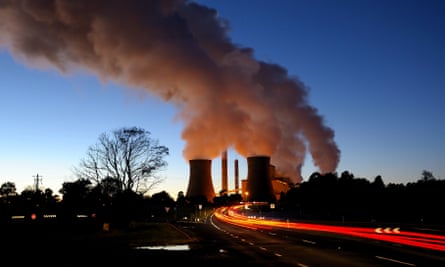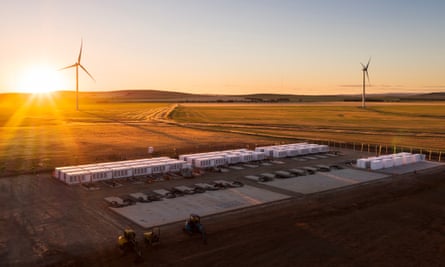There may have been other weeks that packed in as many transformative developments in clean energy in Australia as the past seven days, but they don’t come often.
On Friday, the New South Wales parliament passed laws to build 12 gigawatts of clean energy – roughly equivalent to the country’s entire existing large-scale renewable capacity – and 2GW of energy storage in the state over the next decade.
Remarkably, given Australia’s tortured national climate politics, the legislation had near-unanimous parliamentary support from the Coalition government, the Labor opposition, the Greens and most other crossbenchers. One Nation opposed the bill, filibustering through the night before its eventual passage.
The scale of what the NSW plan will mean for the grid and – despite the cautiousness of MPs when the issue is raised – the early closure of coal-fired power is yet to be fully appreciated. “It’s massive,” says Tristan Edis, a director with the analysis firm Green Energy Markets. “It will produce almost as much electricity as is consumed across South Australia, Western Australia and Tasmania.”
Three days earlier, the Victorian government’s budget included $543m to develop six renewable energy zones. Part of a $1.6bn clean energy commitment, it will be used to buttress and make best use of the solar and windfarms built to meet a state renewable energy target.

Meanwhile, the energy company AGL, the country’s biggest greenhouse gas emitter, announced it would build a large-scale battery next to its Loy Yang A coal plant in Gippsland. It was the third major battery announcement in thrree weeks, following others near Geelong and Adelaide. All are bigger than anything currently in operation in Australia.
Up north near Townsville, a zinc refinery owned by Sun Metals became the first business of its type to pledge it would be run entirely on renewable energy by 2040. Down south, the Tasmanian government boasted the near-complete construction of the Granville Harbour wind farm had tipped the state over to running 100% on renewable energy.
The ramifications of the change were the focus of speakers at an online summit hosted by the Australian Financial Review. Some marvelled at the pace, while others expressed frustration at what they saw as a leap away from a national electricity market towards the sort of state-based central planning that was supposed to have died in the 20th century.
Several analysts said the rapid shift raised another question: where does it leave the Morrison government’s case for new fossil fuel power as part of its touted gas-fired recovery from the Covid-19 pandemic?
Scott Morrison and his federal energy and emissions reduction minister, Angus Taylor, have claimed NSW will need 1,000 megawatts of new flexible electricity capacity that can be called on at any time – so not solar and wind – to replace the Liddell coal plant when it shuts in 2023. They warned the private sector they will instruct the taxpayer-owned Snowy Hydro to build some of it if companies have not made commitments by April.
The idea more gas was needed was heavily contested at the time – and is even more so now.
Taylor responded to the NSW plan by warning it will drive away private investors, pointing to AGL and EnergyAustralia saying they would now delay decisions on gas and battery projects.
The NSW’s plan architect, the energy and environment minister Matt Kean, who has emerged as a media-friendly clean energy evangelist within the Coalition, says his assessment is new gas will not be needed when Liddell shuts.
“We think there are other means that could achieve this,” he said on Friday. “What I am focused on is delivering the infrastructure that will keep the lights on here and drive prices down.”
Kean describes the NSW plan as a “historic victory for the people of NSW” that will spark $58bn in investment over the next 20 years and create thousands of jobs. “Ultimately, NSW is its own government and my job is to put the people of NSW first, and that’s exactly what we’re doing,” he says.
On gas, he argues it has an ongoing role to play in generating electricity “but it’s a very expensive way to do that”.
In terms of actual generation, gas plays a relatively minor role in the national grid, providing about 8% of electricity.
It plays a much smaller role in NSW, providing just 1.4% of the electricity over the past year. The state’s existing gas plants have been operating at just 6% of their capacity. The main reason is pretty clear: the average wholesale price for gas power has been more than twice as expensive as the average across the grid.
Dr Dylan McConnell, a researcher at the University of Melbourne’s climate and energy college, is among those who say the state commitments are pushing gas further out of the picture. “Practically, that is what’s happening,” he says. “At the moment renewable energy is cheaper, but in future it will be the batteries and the 2GW of storage in NSW pushing out gas.”
Simon Holmes a Court, also at the University of Melbourne and a clean energy commentator, says this is in line with forecasts by the Australian Energy Market Operator (Aemo), which suggest a shrinking amount of gas-fired generation over the next 10-15 years. “We are already using less and gas prices are down,” he says. “The fact is, it is struggling because it is competing with cheaper renewables.”
The price of energy is expected to fall further as more solar and wind comes into the system. In both NSW and Victoria, the commitment is not to build the plants, but to sign contracts guaranteeing private investors a minimum price for the electricity they generate. This is already happening in Victoria under the state’s renewable energy target, which has backed 928 megawatts of wind and solar and promised at least another 600MW.
The NSW scheme will support not just solar and wind energy but also two types of storage – long-duration technologies that can provide backup power for eight hours or more (expected to be pumped hydro and batteries) and “fast-start” generators that can whir into action to ensure grid stability when needed (batteries and possibly gas).
Both NSW and Victoria will help pay for the grid connections and other infrastructure needed to get the clean energy online. Tristan Edis says Victoria has perhaps had less credit for its policy than it might have because it has rolled it out gradually, where NSW opted for one big hit.
Other states are heading down a similar path. Queensland has a similar renewable energy zone and auction model run by the state-owned renewable company CleanCo, while Tasmania has contentiously promised 200% renewable energy generation – twice the state’s local demand – by 2040 through a yet-to-be-announced model.
The Morrison government has been critical of some state intervention in the national electricity market, particularly when it believes it is unclear what it will mean for electricity prices. Its opponents argue the states would not be taking these steps if the federal Coalition had not abandoned the field by repealing a national carbon price, dropping plans for some sort of replacement and choosing not to extend the national renewable energy target when it was filled last year.
They also point out the Morrison government is planning its own interventions, particularly to push for new gas-fired power that others say is not needed.
In addition to threatening to build a new gas plant in NSW if private companies don’t, Taylor is trying to push through legislation to allow the taxpayer-owned green bank, the Clean Energy Finance Corporation, to underwrite five “fast-start” gas plants.
The need for additional gas-fired generation to replace the Liddell coal plant is heavily contested. Neither Aemo nor a government-commissioned taskforce looking at the Liddell closure found there would be a shortfall in generation capacity.

Taylor says new gas is needed less to ensure reliable supply, and more to prevent a spike in electricity prices – as happened around the time the Hazelwood coal plant in Victoria shut much more abruptly in 2017.
Again, this has been challenged by analysts who have considered alternatives to new fossil fuels. Research released on Friday by analysts at RepuTex, commissioned by Greenpeace, found the NSW government’s model – renewables backed mostly by batteries – was by far the cheapest option when compared with doing nothing or building a new gas plant.
Where does this leave the case for a gas-fired recovery?
There is a separate, and more complicated, argument about the use of gas for heating and as a chemical feedstock in manufacturing and industry, where it is not always as easily replaced (though independent analysis has found even here the need for new gas, rather than making better use of existing resources and backing cleaner alternatives where possible, is significantly overstated).
But in electricity, the case for new gas in the short-term appears limited.
In its assessment of what an optimal future grid would look like, Aemo found it would increasingly run on large and small-scale renewable energy – potentially by 2035 up to 90% of electricity from solar and wind at times – supported by “dispatchable” generation that can be called on when needed.
That dispatchable generation can come from a range of sources including pumped hydro, batteries and, yes, gas. But Aemo suggested investment in gas was less likely to make sense than cleaner options due to cost. It didn’t consider the impact of the emissions from gas, but it was the only fossil fuel on the list.
Analysts make a similar case, with a caveat. While the amount of gas-fired power generation is expected to continue to fall in the next few years, McConnell and Edis say there may be a case for new plants to be built as more of the country’s coal fleet shuts, depending on how much other technologies have developed.
These plants would hardly ever be used, and would not contribute much to emissions. Gas plants differ from batteries and pumped hydro at the moment in that they can sit idle for all but a few hours a year and be called on only at times of absolute need, as diesel generators are in some places now. By comparison, pumped hydro and batteries need to be called on more regularly to justify their existence.
McConnell says if companies or governments do feel compelled to back gas plants, they would be wise to ensure they can also run on hydrogen, given where the future of energy is headed.
“The reality is complex,” McConnell says. “I’d like to think the answer on new gas is ‘no’ but having gas turbines that are hydrogen-ready may not be the worst thing we can do. But we don’t need them now.”